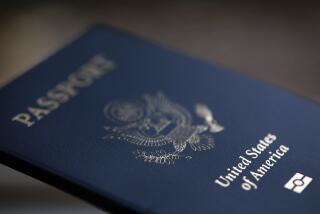Passport law changes: What U.S. travelers need to know
- Share via
Confused about passports? No wonder. The laws that dictate which documents you need to travel to Mexico, Canada, the Caribbean and Bermuda were relaxed this week, the latest in a string of changes. Moreover, passport applications take twice as long to process these days, up to 12 weeks or more — sometimes much more.
Here’s what you need to know about these vital travel documents. Remember that the newest policies were just announced and that some details aren’t clear. The most complete information is at the State Department’s website, www.travel.state.gov. Click on “Passports for U.S. Citizens.”
Question: Do I need a passport to visit Mexico, Canada, the Caribbean or Bermuda?
Answer: Not if you’re a U.S. citizen and traveling before Sept. 30.
But if you plan to fly to these destinations, you must apply for a passport before you leave and present an online receipt from the State Department proving that you applied, plus a government-issued photo ID, such as a driver’s license. These documents are required to reenter the U.S.
Two tips: Apply far in advance because it may take weeks, the State Department says, for your application to become trackable online. And if you do fly without a passport, be prepared to undergo extra scrutiny at security checkpoints, which could delay your passage through the airport.
If you’re flying to Mexico, Canada, the Caribbean or Bermuda after Sept. 30, you must have a passport in hand. If you’re driving or taking a cruise there, you won’t need a passport until at least January. The exact date has yet to be set.
The law notwithstanding, some cruise lines may ask you to carry a passport anyway. One reason is that if you have a medical emergency during your cruise, it may be prudent to fly you back to the U.S. for treatment, and you’ll need a passport to reenter by air.
Q: Do I still need a passport to visit foreign destinations other than Canada, Mexico, the Caribbean and Bermuda?
A: Yes. These rules haven’t changed. A tip: Be sure your passport expiration date is at least six months after you plan to travel. That’s because some countries won’t let you enter or give you a visa if less than six months remains on your passport.
Q: Do I need a passport to travel to or return from a U.S. territory, such as Puerto Rico, the U.S. Virgin Islands or Guam?
A: No. Those rules haven’t changed.
Q: How do I apply for a passport, and how much does it cost?
A: In general, if it’s your first passport or your old one has expired and was issued more than 15 years ago , you’ll need to apply in person at a post office, public library or other government office authorized to receive applications.
There are thousands of these places, searchable by ZIP Code on www.travel.state.gov. Don’t go to a regional passport agency; these deal with last-minute requests and other emergencies and can be visited by appointment only.
Besides filling out an application form, which you can download from the website, you must bring a government-issued photo ID; a birth certificate or other proof of U.S. citizenship; two current photos of yourself; and the required fee. The specifications for the photos, found on the website, are quite specific.
If you need only to renew your passport, you don’t have to appear in person; you can complete this process by mail.
Fees are $97 for your first passport and $67 for renewals. Passports are good for 10 years.
Different rules and fees apply to children. See the website for details.
Q: How long does it take to get a passport?
A: Longer than you probably think.
Passports used to arrive within six weeks after you applied. Then it was 10 weeks. In its latest posting, the State Department says that because of a surge in applications, it can take up to 12 weeks. Some postal employees and travel agents suggest allowing 16 weeks or more.
If you make a mistake on your application, such as submitting a photo that’s too small or sending the wrong fee, it could take even longer. That’s because the State Department typically rejects such an application, returns it to you and the clock starts over.
Q: Can I do anything to speed things up?
A: Maybe. For an $60 more, you can request “expedited service,” which the State Department says will get the passport to you in two or three weeks. However, with the current backup, Times readers have reported longer waits.
Another option is to entrust your application to a private expediting service. This isn’t cheap — it can cost $100 and up, plus the government’s expediting fee — and it’s no guarantee. But these companies have standing appointments at passport agencies, which gives them a better shot at pushing through applications.
One way to find an expediter is to visit www.napvs.org, the website of the National Assn. of Passport & Visa Services. The website links to its members, which include many of the bigger companies.
Q: How do I check the status of my application?
A: You can do this online at the State Department’s website. But it may take up to four weeks for the information to become trackable, the department says. Some readers have complained that it is inaccurate or doesn’t show up at all.
You can also send an e-mail, but responses may take several days. Don’t bother to phone; the lines are too backed up.
Q: What should I do if I’m due to leave for my trip within two weeks and I don’t have my passport?
A: You have a problem, and it’s not easy to solve, unless you can take advantage of the temporary passport waiver for Mexico, Canada, the Caribbean or Bermuda (see above).
Otherwise, the State Department advises that you call for an appointment at a regional passport agency — if you’re lucky enough to live near one. There are 13 in the U.S., mostly in big cities. The toll-free phone is (877) 487-2778.
Despite adding more capacity and staff, the line is overloaded. Readers report lengthy waits or say they can’t get through at all.
jane.engle@latimes.com
More to Read
Sign up for The Wild
We’ll help you find the best places to hike, bike and run, as well as the perfect silent spots for meditation and yoga.
You may occasionally receive promotional content from the Los Angeles Times.






